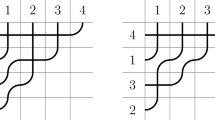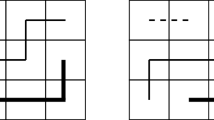Abstract
The decomposition of a product of two irreducible representations of a linear group Gl(N, ℂ) is explicitly given by the Littlewood-Richardson rule, which amounts to finding how many Young tableaux satisfy certain conditions. We obtain more general multiplicities by generating ‘vexillary’ permutations and by using partially symmetrical polynomials (Schubert polynomials).
Similar content being viewed by others
References
Biedenharn, L. C. and Louck, J. D., ‘Angular Momentum in Quantum Physics, Racah Wigner Algebra’, Encycl. of Maths Vols. 8, 9, Addison-Wesley, 1981.
LascouxA. and SchützenbergerM. P., Comptes Rendus Acad. Paris. 294, 447 (1982).
Lascoux, A. and Schützenberger, M. P., in Invariant Theory, Springer Lecture Notes in Maths No. 996.
Littlewood, D. E., The Theory of Group Characters, Oxford, 1950.
Macdonald, I. G., Symmetric Functions and Hall Polynomials, Oxford Maths Mono., 1979.
StanleyR., J. Math Phys. 21, 2321–2326 (1980).
StanleyR., J. Europ. Comb. 5, 359–372 (1984).
Author information
Authors and Affiliations
Additional information
A la mémoire de S. Ulam, exemple et ami.
Rights and permissions
About this article
Cite this article
Lascoux, A., Schützenberger, MP. Schubert polynomials and the Littlewood-Richardson rule. Lett Math Phys 10, 111–124 (1985). https://doi.org/10.1007/BF00398147
Received:
Issue Date:
DOI: https://doi.org/10.1007/BF00398147




